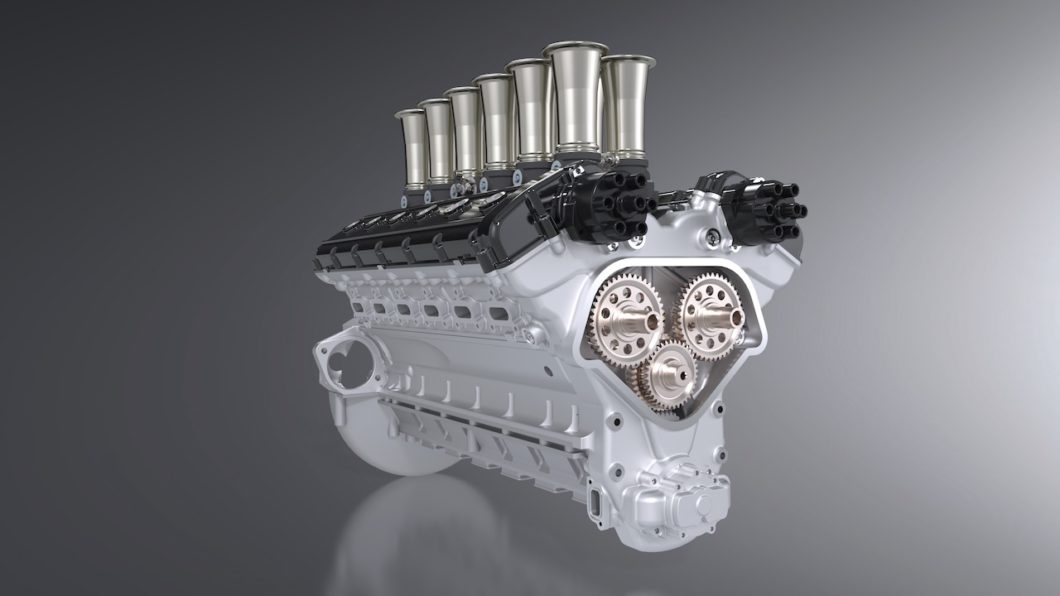GTO Engineering, which announced the name of its hand crafted sub-1,000 kg sports car last month, has revealed more details about the bespoke 460bhp quad-cam V12 engine that will power the new Squalo.
The firm is aiming to rewrite the rule books with the Squalo and is targeting a sub 165kg weight from its hand-built naturally aspirated 4.0-litre quad-cam V12 engine, which well rev to an impressive 10,000rpm. A strict focus on lightness is the core goal for the Squalo’s in house development team, a singular purpose that will make the V12 as light and as enjoyable to drive as possible.
The team has three criteria within the lightweight and drive-ability objective. The first is to ensure that the V12 is as at home on a grand tour as it is on track. The second, to make it as light as possible, which means analysing and bettering every component. The third is to use modern manufacturing processes and materials to create what they believe to be the ultimate V12 road car engine.
“People often ask us what the similarities are between Squalo and any 250-series car, and it’s easier to say this: there are none. There aren’t any parts that are shared between the Squalo and any 250-series model, and one key case study for that is the engine, said GTO Engineering Managing Director and Founder Mark Lyon.
“We know most V12 Ferraris inside out, and recently weighed a 1960 4.0-litre V12 engine; it was 176kg as a complete unit with the starter motor, oil and oil filler tubes too. That’s so much lighter than a modern V12, and we know we can do even better with our knowledge as well as modern advancements and techniques. Every part and configuration on our quad-cam V12 has had a complete engineering re-focus to ensure our engine for Squalo is the very best it can be.”
Every component has been completely re-evaluated and revised to create a lighter and tighter-packaged V12 that will power the car. Targeting a total weight of sub-165kg, the team has been hollowing parts and looking at advanced material selection across the entire engine. The starter motor has been put on a diet and a 25% lighter (when compared to equivalents) clutch and flywheel has been selected and is undergoing development testing on the development mule.
Likewise, the team has spent a lot of time working to optimise the engine layout within the vehicle, aiming for a 55/45 weight distribution. To target a low centre of gravity the engine will be dropped further towards the cabin and lower towards the floor. The engineers have also designed heavy items to be placed at the back of the car, so the rear fuel tank, rear-mounted transaxle will provide weight over the rear of the car as well as the battery.
Advanced manufacturing skills are being used for not only the prototyping stage but also full production. GTO Engineering is using its own additive manufacturing (AM) systems to 3D print prototype parts and is also investigating AM tooling for the engine casing, once again proving it is using cutting edge technical knowledge and new engineering technology to apply new ways of thinking to an older engine layout.
The engine development has also focused on aesthetics and design with significant attention being given to the packaging of the entire engine. The team has tried to make the packaging as compact as possible while also retaining the look – aimed to be an exciting experience to view under the bonnet as much as it is to drive it. A prime example of this attention to detail is that the entire air cleaner assembly has been incorporated so that when the bonnet’s lifted you just see the open trumpets. The front timing case and ancillary drives have been remodelled to be sleeker, so has main bearing sump assembly and likewise the distributor caps are now going to be designed and made in house due to the team not finding an aesthetically pleasing off-the-shelf part.
The quad-cam V12 will be built by hand at GTO Engineering’s headquarters, where all of its engine research and development is currently being carried out. At the time of writing this press release GTO Engineering has defined the cylinder head design, which is now going into the tooling phase of manufacturing production. The team has confirmed and specified the ignition system as well as specifying the air conditioning packaging and processor, and will also be made available to be packaged for any low-volume car manufacturer or bespoke build requirements.
This development update on the engine follows the initial renderings and intentions for the new vehicle, which was initially announced in November 2020. Since then, the team continues to grow with in-house and external consultants collaborating together, all working on the same goal to create one of the most exciting enthusiast cars of the decade, with the first customer deliveries in 2023.








